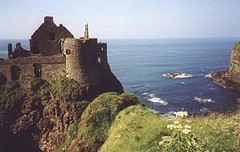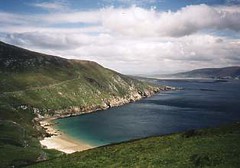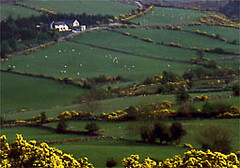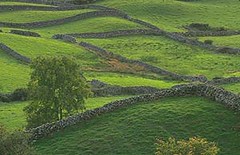 "No Greater Love"
"No Greater Love"
by Robert Grace
EXCRUCIATE: to cause great agony, torment
Latin : ex : out of, from cruciate : cross
"from the cross"
You've read the Gospel accounts of this. They are moving in their very simplicity, the speed with which the action occurs. Yet, because the witnesses were familiar with a Crucifixion, fully descrbing it was not considered. We are left to imagine the act, and the suffering of Jesus, as he is executed by the Romans. So what happens on that day? What were the Gospels describing?
The Jewish man has been arrested, tried illegally by the religious authorities, and convicted of proclaiming himself GOD. He has been given over to the ruling military authorities of the region, and beaten. Offered to his own people, as an innocent man and undeserving of further punishment, those people refuse him and demand that he be executed. The legal authority makes a display of being innocent of anything, by ostentatiously washing his hands, then sends the innocent man to be brutally scourged and executed.

The man has been beaten, with fists and sticks. He has been flogged with a whip, the ends of which are embedded with bits of metal and bone so as to bite into the flesh and muscle. Unlike most victims of this sort of flogging - scourging - who are whipped perhaps but a few times so as to prolong their coming execution, this man has received the full forty lashes. A circle of thorny vines has been fashioned into a kind of crown and pushed down onto the man's head. He is then beaten with sticks once again. He is not only in shock, and nearly exhausted beyond his own ability to stay on his feet, but he is bleeding profusely, and is in physical pain of unimaginable depth.
The skin of his back, his chest and arms, and his legs, hangs in bloody strips, the nerves cut, bruised, and exposed to the air and the man's sweat. The thorns upon his head dig deeply into his scalp, impaling the nerves on his head so that every movement brings excruciating pain to pulse over his face and down his neck. A soft breeze becomes an instrument of torture as they move the crown of thorns.

Barely capable now of standing, the man has a wooden cross, or cross-piece, put onto his shoulders and he is ordered to drag it to the place of his execution.

Unable to hold the heavy wooden object up, a by-stander is pulled from the crowd and forced to carry it in the man's stead. The crowd pushes close to see the tortured man and to jeer at him, some to weep at his plight.

Jesus is aware enough to speak to them and admonish them, saying,
Luke 23:28 - 31:
"But Jesus turning unto them said, Daughters of Jerusalem, weep not for me, but weep for yourselves, and for your children. For, behold, the days are coming, in the which they shall say, Blessed [are] the barren, and the wombs that never bare, and the paps which never gave suck. Then shall they begin to say to the mountains, Fall on us; and to the hills, Cover us. For if they do these things in a green tree, what shall be done in the dry?"
The guards keep them back so they will not interfere with this execution.

Upon reaching the execution place, He is stripped of His garments, thrown on his back, dragged into place on the cross, and the execution begins. It is a Crucifixion, an ancient form of execution that has become somewhat popular with Roman authorities. It is a humiliating, painful way to die. The very word describes the experience: excruciating.

The Romans use large iron nails or spikes to affix the man to the cross-piece.

They drive the nails into the space between the small bones of His wrist (the wrist is considered part of the hand in Ancient times), or they are driven into the base of the thumb angled so as to pass through the wrist. This is not always used in Crucifixions. Tying the victim prolongs the death. Nailing him makes the death quicker and far more painful. This is a form of torture the man from Nazareth is experiencing. And the pain he has been suffering has now been magnified.

His feet or ankles are impaled to the base of the upright, at an angle, so that his knees are bent. This will allow Him to push himself up so He can breath. It is not a form of mercy by the Romans - it is another addition to the torture. Sometimes the victim's feet are nailed through the Achilles tendon on either side of the upright. Gruesome, indeed.
When death comes it is usually caused by many things, among them asphyxiation as the victim can no longer hold his body up so He can breath. But the one form of mercy the Romans will show the crucifixion victim is to break their lower legs. This will cause enormous shock, and the victim will not be able to hold himself up. A quicker death is the only mercy the Romans will show.
This man, this Jesus of Nazareth, is being executed for no crime at all. Accused of blasphemy by the Jewish Authorities in their midnight illegal trial, He cannot be guilty because He is Who He claims to be. He cannot be found guilty because the prosecutors cannot find two witnesses against Him. But they find Him guilty nonetheless, beat Him, mock Him, and turn Him over to the Romans. They demand that the Romans execute this Jesus. And they lie to the Romans to see that He is executed.
Pontius Pilate, the Roman authority finally agrees and executes the Nazarene man. Not one of us can fail to recognize the pain that being beaten entails, nor the pain of having a sharp tool driven into our flesh. But what happened to Jesus went beyond what we can imagine in our own minds. So we can turn to experts on the human body to explain what happened.
From
Dr. C. Truman Davis:
About a decade ago, reading Jim Bishop's The Day Christ Died, I realized that I had for years taken the Crucifixion more or less for granted -- that I had grown callous to its horror by a too easy familiarity with the grim details and a too distant friendship with our Lord. It finally occurred to me that, though a physician, I didn't even know the actual immediate cause of death. The Gospel writers don't help us much on this point, because crucifixion and scourging were so common during their lifetime that they apparently considered a detailed description unnecessary. So we have only the concise words of the Evangelists: "Pilate, having scourged Jesus, delivered Him to them to be crucified -- and they crucified Him."
[...]the physical passion of the Christ began in Gethsemane. Of the many aspects of this initial suffering, the one of greatest physiological interest is the bloody sweat. It is interesting that St. Luke, the physician, is the only one to mention this. He says, "And being in Agony, He prayed the longer. And His sweat became as drops of blood, trickling down upon the ground."
Every ruse (trick) imaginable has been used by modern scholars to explain away this description, apparently under the mistaken impression that this just doesn't happen. A great deal of effort could have been saved had the doubters consulted the medical literature. Though very rare, the phenomenon of Hematidrosis, or bloody sweat, is well documented. Under great emotional stress of the kind our Lord suffered, tiny capillaries in the sweat glands can break, thus mixing blood with sweat. This process might well have produced marked weakness and possible shock.
After the arrest in the middle of the night, Jesus was next brought before the Sanhedrin and Caiaphas, the High Priest; it is here that the first physical trauma was inflicted. A soldier struck Jesus across the face for remaining silent when questioned by Caiaphas. The palace guards then blind-folded Him and mockingly taunted Him to identify them as they each passed by, spat upon Him, and struck Him in the face.
 In the early morning, battered and bruised, dehydrated, and exhausted from a sleepless night, Jesus is taken across the Praetorium of the Fortress Antonia, the seat of government of the Procurator of Judea, Pontius Pilate. You are, of course, familiar with Pilate's action in attempting to pass responsibility to Herod Antipas, the Tetrarch of Judea. Jesus apparently suffered no physical mistreatment at the hands of Herod and was returned to Pilate. It was in response to the cries of the mob, that Pilate ordered Bar-Abbas released and condemned Jesus to scourging and crucifixion.
In the early morning, battered and bruised, dehydrated, and exhausted from a sleepless night, Jesus is taken across the Praetorium of the Fortress Antonia, the seat of government of the Procurator of Judea, Pontius Pilate. You are, of course, familiar with Pilate's action in attempting to pass responsibility to Herod Antipas, the Tetrarch of Judea. Jesus apparently suffered no physical mistreatment at the hands of Herod and was returned to Pilate. It was in response to the cries of the mob, that Pilate ordered Bar-Abbas released and condemned Jesus to scourging and crucifixion.
Now, recall that Jesus was a carpenter, as it is supposed, and was in excellent physical condition. He was also a preacher who walked everywhere and traveled great distances. This was not some sickly, weak man. As
Cahleen Shrier, Ph.D., an associate professor in the Department of Biology and Chemistry at Azusa Pacific University puts it:
It is important to understand from the beginning that Jesus would have been in excellent physical condition. As a carpenter by trade, He participated in physical labor. In addition, He spent much of His ministry traveling on foot across the countryside. His stamina and strength were, most likely, very well developed. With that in mind, it is clear just how much He suffered: If this torture could break a man in such good shape, it must have been a horrific experience.
It was. And we have, as Christians, watered down the very horror of Christ's execution to the point where it is a mere mention between Good Friday and the colored eggs of Easter morning. And this horrible death began as a Supper with friends, if you will, which we remember as The Last Supper.
As described by
David Terasaka, MD, in "Medical Aspects of the Crucifixion of Jesus Christ":
From the upper room, Jesus went outside of the city walls where he spent time in prayer at the Garden of Gethsemane. The garden has many ancient olive trees today, some of which may have grown from the roots of the trees that were present in Jesus' time. (All trees in and around Jerusalem were cut down when the Romans conquered the city in 70 A.D. Olive trees can regenerate from their roots and live for thousands of years.) The name "Gethsemane", comes from the Hebrew Gat Shmanim, meaning "oil press" (Kollek). Since "oil" is used in the Bible to symbolize the Holy Spirit, it may be said that the garden is where "the Spirit of God was crushed" (Missler). It was here that Jesus agonized in prayer over what was to occur. It is significant that this is the only place in the KJV where the word "agony" is mentioned (Strong's concordance). The Greek word for agony means to be "engaged in combat" (Pink) Jesus agonizes over what He is to go through, feeling that He is at the point of death.(Mark14:34) Yet He prays, "Not my will, but thine be done."
Cahleen Shrier describes the scourging:
Traveling from Pilate to Herod and back again, Jesus walks approximately two and a half miles. He has not slept, and He has been mocked and beaten (Luke 22:63-65). In addition, His skin remains tender from the hemohedrosis. His physical condition worsens.
Pilate orders Jesus to be flogged as required by Roman law before crucifixion Traditionally, the accused stood naked, and the flogging covered the area from the shoulders down to the upper legs. The whip consisted of several strips of leather. In the middle of the strips were metal balls that hit the skin, causing deep bruising. In addition, sheep bone was attached to the tips of each strip.
When the bone makes contact with Jesus’ skin, it digs into His muscles, tearing out chunks of flesh and exposing the bone beneath. The flogging leaves the skin on Jesus’ back in long ribbons. By this point, He has lost a great volume of blood which causes His blood pressure to fall and puts Him into shock. The human body attempts to remedy imbalances such as decreased blood volume, so Jesus’ thirst is His body’s natural response to His suffering (John 19:28). If He would have drank water, His blood volume would have increased.
Roman soldiers place a crown of thorns on Jesus’ head and a robe on His back (Matthew 27:28-29). The robe helps the blood clot (similar to putting a piece of tissue on a cut from shaving) to prevent Jesus from sustaining more blood loss. As they hit Jesus in the head (Matthew 27:30), the thorns from the crown push into the skin and He begins bleeding profusely. The thorns also cause damage to the nerve that supplies the face, causing intense pain down His face and neck. As they mock Him, the soldiers also belittle Jesus by spitting on Him (Matthew 27:30). They rip the robe off Jesus’ back and the bleeding starts afresh.
Jesus’ physical condition becomes critical. Due to severe blood loss without replacement, Jesus is undoubtedly in shock. As such, He is unable to carry the cross and Simon of Cyrene executes this task (Matthew 27:32).
Crucifixion was invented by the Persians between 300-400 B.C. It is quite possibly the most painful death ever invented by humankind. The English language derives the word “excruciating” from crucifixion, acknowledging it as a form of slow, painful suffering.1 Its punishment was reserved for slaves, foreigners, revolutionaries, and the vilest of criminals. Victims were nailed to a cross; however, Jesus’ cross was probably not the Latin cross (†), but rather a Tau cross (T). The vertical piece (the stipes) remains in the ground permanently. The accused carries only the horizontal piece (the patibulum) up the hill. Atop the patibulum lies a sign (the titulus), indicating that a formal trial occurred for a violation of the law. In Jesus’ case, this reads “This is the King of the Jews” (Luke 23:38).
The accused needed to be nailed to the patibulum while lying down, so Jesus is thrown to the ground, reopening His wounds, grinding in dirt, and causing bleeding. They nail His “hands” to the patibulum. The Greek meaning of “hands” includes the wrist. It is more likely that the nails went through Jesus’ wrists. If the nails were driven into the hand, the weight of the arms would cause the nail to rip through the soft flesh.
Therefore, the upper body would not be held to the cross. If placed in the wrist, the bones in the lower portion of the hand support the weight of the arms and the body remains nailed to the cross. The huge nail (seven to nine inches long)2 damages or severs the major nerve to the hand (the median nerve) upon impact. This causes continuous agonizing pain up both of Jesus’ arms.
Once the victim is secured, the guards lift the patibulum and place it on the stipes already in the ground. As it is lifted, Jesus’ full weight pulls down on His nailed wrists and His shoulders and elbows dislocate (Psalm 22:14).3 In this position, Jesus’ arms stretch to a minimum of six inches longer than their original length.
It is highly likely that Jesus’ feet were nailed through the tops as often pictured. In this position (with the knees flexed at approximately 90 degrees),4 the weight of the body pushes down on the nails and the ankles support the weight. The nails would not rip through the soft tissue as would have occurred with the hands. Again, the nail would cause severe nerve damage (it severs the dorsal pedal artery of the foot) and acute pain.
Normally, to breathe in, the diaphragm (the large muscle that separates the chest cavity from the abdominal cavity) must move down. This enlarges the chest cavity and air automatically moves into the lungs (inhalation). To exhale, the diaphragm rises up, which compresses the air in the lungs and forces the air out (exhalation). As Jesus hangs on the cross, the weight of His body pulls down on the diaphragm and the air moves into His lungs and remains there. Jesus must push up on His nailed feet (causing more pain) to exhale.
In order to speak, air must pass over the vocal cords during exhalation. The Gospels note that Jesus spoke seven times from the cross. It is amazing that despite His pain, He pushes up to say “Forgive them” (Luke 23:34).
The difficulty surrounding exhalation leads to a slow form of suffocation. Carbon dioxide builds up in the blood, resulting in a high level of carbonic acid in the blood. The body responds instinctively, triggering the desire to breathe. At the same time, the heart beats faster to circulate available oxygen. The decreased oxygen (due to the difficulty in exhaling) causes damage to the tissues and the capillaries begin leaking watery fluid from the blood into the tissues. This results in a build-up of fluid around the heart (pericardial effusion) and lungs (pleural effusion). The collapsing lungs, failing heart, dehydration, and the inability to get sufficient oxygen to the tissues essentially suffocate the victim.5 The decreased oxygen also damages the heart itself (myocardial infarction) which leads to cardiac arrest. In severe cases of cardiac stress, the heart can even burst, a process known as cardiac rupture.6 Jesus most likely died of a heart attack.
After Jesus’ death, the soldiers break the legs of the two criminals crucified alongside Him (John 19:32), causing suffocation. Death would then occur quicker. When they came to Jesus, He was already dead so they did not break His legs (John 19:33). Instead, the soldiers pierced His side (John 19:34) to assure that He was dead. In doing this, it is reported that “blood and water came out” (John 19:34), referring to the watery fluid surrounding the heart and lungs.
There is also a mystery here, not the one associated with the Resurrection. During the time while Christ was on the cross, yet still lived, the Bible relates that the sky darkened as if it was night. But it was not night but the middle of the day (noon to three p.m.). I know that there are theological implications to this. My own belief is that since Jesus was taking onto Himself the responsibility for the Sins of all humanity, GOD must pour out HIS righteous wrath on Jesus. That is the penalty. Nothing less will suffice to redeem mankind from eternal death. And so to hide what is being done to HIS only son, I believe that GOD caused the darkness so that no human would witness this punishment. If you think the Romans can cause pain, imagine the Living GOD meting out punishment to HIS only son.
When HE was finished with the punishment, the darkness receded, and Jesus Christ said, "It is finished," and died. He died so quickly that Pilate was astonished. He expected Jesus to linger for two days or more. He was not counting on the Wrath of Heaven to speed the process. After all, Christ had to die quickly so that He could be entombed quickly. For the greatest miracle of all was going to happen on the third day. And that is for another day.
 "My Son, My Son" by Danny Hahlbohm
"My Son, My Son" by Danny Hahlbohm
Bear in mind that beyond His suffering, His followers suffered,
and so did His mother, Mary. She watched her own son be executed. C. Truman Davis: "
A Physician Analyzes the Crucifixion"
David Terasaka, M.D.: "
Medical Aspects of the Crucifixion of Jesus Christ"
Cahleen Shreir, PDd.: "
The Science of the Crucifixion"
Dr. Mark Eastman: "
Medical Aspects of The Crucifixion: Agony of Love"





























